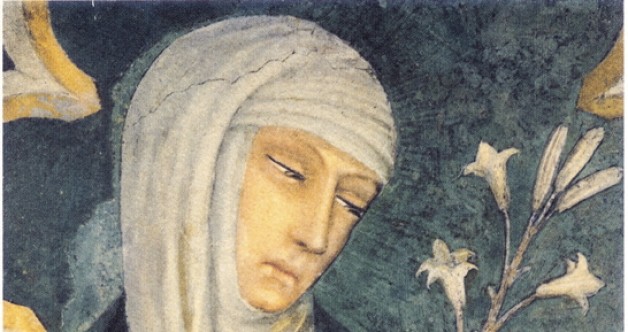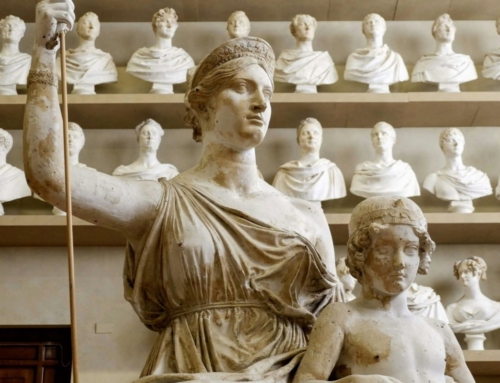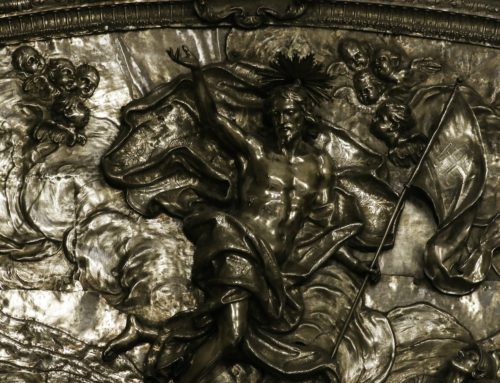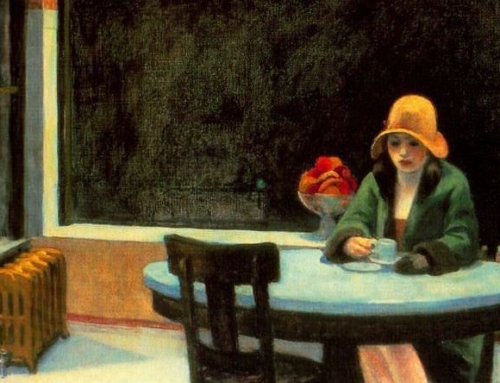On the evening of that first day of the week, when, for fear of the Jews, the doors were locked where the disciples were, Jesus came and stood in their midst and said to them, “Peace be with you.”
—John 20:19
It wasn’t just Peter, of course. The others had also denied Jesus. When he asked them to stay awake with him and keep watch, they had slept. When he was arrested, they had fled. When he was condemned to death, they had kept their distance. And now he was dead. It was evening, and the doors were locked.
The Apostles were paralyzed, overcome with guilt, fear, and doubt: guilt because of their faithlessness and cowardice, fear because of the Jews, doubt because they couldn’t believe what Mary Magdalene had told them—that she had seen the Lord. In fact, maybe they were half hoping it wasn’t true. For if it were true, if she had seen Jesus, why hadn’t he also appeared to them? Was it because, after their desertion, he wanted nothing more to do with them? On the other hand, if he was coming to see them, what sort of reunion could they expect? A joyful meeting of parted friends? Or a fearful visitation of divine wrath? After all, they had seen their Lord get angry before. Tables had flown in the Temple, and: “Get behind me, Satan.”
So the doors were locked—yes, against the Jews, but also, perhaps, somewhere in the back of the Apostles’ minds, against Jesus.
It is the same with us. In one way or another, we lock our hearts against the coming of Christ and, in the darkness of fear and doubt, kindle our own feeble lights. Like the Apostles, we do this even after Jesus has called us friends, washed our feet, died for our sake. Like the Apostles, we have lived long enough to learn that this world is no home for us, and yet still we hesitate. When the world no longer enchants, it retains its power to disenchant, and we are tempted to think, “Perhaps death is the end, and the Gospel is just a woman’s delusion after all.” Mary Magdalene was seeing things. Lock the doors.
Then Jesus came, and it was evening. St. Bede says something very beautiful about this: “He came in the evening because they would be most afraid at that time.” (Remember that Jesus had been arrested at night.) Notice, too, that Christ did not overawe them with the fullness of his glorified state. Rather, as St. Augustine says, “He accommodated his presence to man’s weak sight, and presented himself in such form that his disciples could look at and recognize him.” And, far from rebuking them for their lack of faith and cowardice, he calms their fears with the words, “Peace be with you”—as if to say, “I understand how sorry you are, and I forgive you.”
Divine mercy is a special theme of the Easter season, and it is nowhere more poignantly expressed, perhaps, than in the many encounters between the risen Christ and his disciples. If we take a step back, however, and consider God’s mercy from a more theological perspective, we can appreciate its presence and significance, not just during Easter, but at all times.
We tend to think of divine mercy as a response to our own sinfulness, and that’s certainly very fitting. But in reality it’s something much broader than that. In fact, it’s simply an aspect of God’s goodness and, therefore, a necessary part of all he does for his creatures. Now, according to St. Thomas, the essential feature of divine goodness is to communicate perfections—to make better or fulfill that which can be bettered or fulfilled—and this communication can be described in different ways. For example, insofar as God bestows perfections on his creatures, not for his own use, but only on account of his goodness, we call his goodness “liberality.” Again, insofar as he bestows perfections on his creatures in due proportion, we call his goodness “justice.” Finally, insofar as he bestows perfections to remedy or expel defects, we call his goodness “mercy.”
Justice and mercy, then, are really different aspects of the same thing, and this helps us to see how, far from being opposed to each other, they are in fact complementary. On the one hand, a just punishment can be merciful because it helps to remedy defects in the offender, and, on the other hand, a work of mercy (e.g., feeding the hungry) can be just because it is “in due proportion” (i.e., it is owed or due to another). In each case, we are describing different sides of one reality.
None of this stands in the way of the fact that mercy has a certain priority over justice (or “triumphs over judgment” (Jas 2:13)) inasmuch as it often goes beyond the minimum that justice demands. So, to give someone more than he deserves is not unjust, but rather, we might say, super just. As Hamlet observes to Polonius, such “justice” is the mercy on which we all depend before God and men. Likewise, St. Thomas says that every manifestation of God’s justice springs from a prior manifestation of his mercy, going back to that primordial work of mercy, the act of creation itself.
Today we celebrate the feast of a great Dominican saint, who also happens to be one of the great women of history: Catherine of Siena (1347–1380). Her famous Dialogue—more or less a transcription of four days’ worth of her ecstatic prayer—is a profound meditation on God’s love and mercy. Since the original work had no title, many have been given to it, but perhaps none is more fitting than that of the French translator, Père Hurtaud, who called it simply The Book of Mercy. Toward the end, God says to Catherine,
I have told you that I wish to show the world mercy so that you can see that mercy is the sign by which I am known. For through the mercy and the inestimable love that I have for man, I sent to earth the Word, my only-begotten Son. (IV, 5, 10)
✠
Image: Andrea Vanni, St. Catherine of Siena (San Domenico, Siena) (Andrea Vanni, a Sienese artist and disciple of St. Catherine, painted this image of her on a pillar in the Church of St. Dominic in Siena. St. Catherine was in her early twenties at the time. Vanni’s is the only authentic portrait of St. Catherine we possess. The lily and the kneeling woman (not shown) were added after Catherine’s death.)







